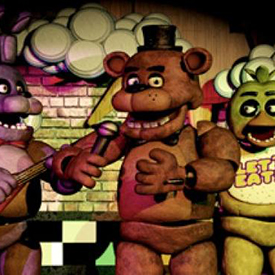 As a kid, I never liked Tolkien very much. I loved The Hobbit, like anyone did, but couldn’t ever obsess over Lord of the Rings. I could never get past the writing style heavy on description, the obsession with landscapes and language.
As a kid, I never liked Tolkien very much. I loved The Hobbit, like anyone did, but couldn’t ever obsess over Lord of the Rings. I could never get past the writing style heavy on description, the obsession with landscapes and language.Now, as I get older, as I try to write my own fantasy, I’m coming to appreciate Tolkien’s intense amount of work more and more. I’m reading The Silmarillion, for the first (and hopefully only) time, and while I am in no way enjoying it I’m marveling at the amount of effort that went into the world. It’s one thing to read about it—oh, he created languages for his world—and quite another to realize that everyone has names in every language, and every language is very probably a real thing.
It’s a feeling quite familiar to me, though. It’s the feeling I got after playing puzzle/platformer Fez for the first time.
Fez had its start, like the game I wrote about last week, as an Independent Games Festival winner. In Fez’s case, it won twice: once for visual design in 2008, when it was first announced, and then as a grand prize winner in 2012, when it was released. Its central concept, living as a two dimensional character in a three dimensional world, captivated immediately. You rotate the world around as the befezzed protagonist, and see things from different angles. Maybe you rotate the world and find people living on the other side; the point is, you don’t know. There could be anything.
But that’s not all of Fez. There’s more to the game than just rotating the world. As you proceed around the game’s charming floating islands, you’ll find strange places, remnants of what appear to be ancient civilizations. You’ll find writing on the walls. You’ll find strange pictures, strange pictographs, that don’t make any sense. At first blush these feel like these are flavorful background text you’re not supposed to interact with. How many video games have made pointless fake languages, fake symbols to dress up their cardboard-flimsy worlds, after all?
Then you find a QR code in the background. “It can’t be real,” you say. QR codes look cool; they’re fine background material. You don’t do something stupid like scan it, because that would be stupid. You’d have to hold your phone up to the TV. Someone could walk in, and you’d never be able to explain it.
Meanwhile, you find more and more letters, and the questions deepen: is this real? Is this a thing? More pictograms; are you supposed to do something with these? You can’t really replicate their movements with your commands—rotate, jump, et cetera—so they can’t be real. There’s another QR code, and, finally, you scan it.
It’s real, and it tells you something. Something important; it doesn’t matter what it is. It’s something you wish you’d known a little bit before. You begin seeing the world in a different light. You begin to find things, little organic notes, that make it seem like the words you’re finding aren’t just background scribblings: they’re a language. They’re notes, left here for you. They’re here to tell you nontrivial things about the game.
Video games don’t tend to reach this level of obsessiveness. They go for compulsive loops of punching and questing instead of something labor intensive like language. Fez does it, though. While other games are content to follow the fantasy boilerplate—pick some words that resemble a real-world Earth language, make them into a “language” you can use—Fez goes full Tolkien: it makes a real language. Sure, it’s pretty much just a cypher, but it works into the game and its fiction. Just like Tolkien turned a fantasy novel into a full-on history of an imagined world, Fez turns a simple puzzle/platformer into an archaeological expedition into a retro-styled world.
In short, Fez opens up into a game entirely different than the one promised. It’s still a puzzle game, but one with linguistic and atmospheric puzzles instead of traditional, “Press this switch, jump on that,” video game puzzles. It rewards obsession, careful analysis, and thoughtful study—like a good puzzle should—while allowing you the freedom to attack or ignore its meaty underbelly should you choose to.
Here’s an example of that: the first time I played Fez, I didn’t learn about the language at all. I didn’t find any of the secrets. I missed half the game. More like two thirds of the game, because I didn’t find a whole section of the its levels. Now, I’m not the ideal puzzle player—I’m about as observant as a bag of clams—but this made the game that much more exciting when I realized, wait, there’s a whole world here, behind the rotating dimensions and clever puzzles. Replaying it after its recent PC rerelease, I’m still missing a ton of places. I haven’t found them yet.
And, I think, it comes back to what makes Tolkien different from a lot of his imitators, even though I happen to like a lot of them. Fez is a game where the developers were confident enough to add whole worlds of stuff that many players won’t even see, just like the average Tolkien fan doesn’t care a whit about The Silmarillion. Video games tend to be loud, all-in things: someone like Bioware makes a fantasy epic like Dragon Age and makes sure all the lore corresponds to something you’re going to do because otherwise it’s wasted man hours. Everything has to go towards the final product.
Fez doesn’t work like that, and that’s why it doesn’t feel like a product. It feels like a world you can go and explore.
Please take a moment to support Amazing Stories with a one-time or recurring donation via Patreon. We rely on donations to keep the site going, and we need your financial support to continue quality coverage of the science fiction, fantasy, and horror genres as well as supply free stories weekly for your reading pleasure.
https://www.patreon.com/amazingstoriesmag










